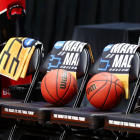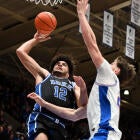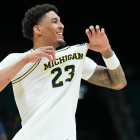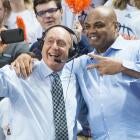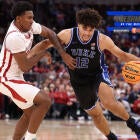Coronavirus fallout: The biggest questions, concerns facing college basketball and athletic departments
There are huge issues with the potential impact COVID-19 will have on college basketball and intercollegiate athletics
As the United States struggles to secure a foothold in the fight against the coronavirus pandemic, college sports is in a precarious position. College athletics is mostly at a standstill, but that new and uncomfortable reality hasn't stopped questions, concerns or curiosities from mounting. In the coming weeks they'll only grow more widespread.
"I've been focused mostly on just my own daily schedule so that I don't become distracted going down the rabbit's hole to check social media to see the latest on (the coronavirus)," one coach said.
CBS Sports spent the past week talking with nearly 20 people in college basketball/athletics, namely head coaches across the country at various levels of Division I, in addition to athletic directors and conference commissioners. There are more questions than answers because there is no projectable short- or long-term plot for college athletics and college basketball. For that reason, most feel troubled.
These are people concerned, first and foremost, over the same issues you and I are concerned about: well-being of their loved ones and themselves; a hope that society can come together and implement consistent social distancing by staying at home and doing everything possible to bring this country back to normal; and relying on medical experts to shepherd us to that return. It's important to note that, throughout all my phone interactions, this sentiment was expressed most passionately by all. Though college sports is facing looming crises across many of its proverbial seas, the most pronounced worries are tied to everyday life that have nothing to do with athletics.
We are living through history.
Coronavirus issues are hitting not just close to home, but at home for some. One coach out west shared that his wife is an ICU doctor who treated a COVID-19 patient as far back as a month ago.
"By the time it got to affecting basketball, I was pretty studied up on it and was shocked we moved as slowly as we had," he said.
Another coach, on the East Coast, said he has family members who have contracted the disease. Yet another wondered aloud the possibility that a couple of people in his program could have unknowingly contracted coronavirus many weeks ago, prior to it being a national emergency, recalling symptoms those people had.
The pandemic has pierced its way into the lives of a lot of powerful people, and it's because of its presence that certain reliables -- like a busy, noisy coaching carousel -- have slowed to speeds not seen since maybe the 1970s. To this point only 18 schools have made coaching changes. That's 30-plus below the normal turnover rate, with none of those moves coming from a Major Seven conference. So yes: these real-life situations are affecting decision-making that have led to a push of the pause button.
Where is college basketball headed? The biggest topic up for extrapolation right now is unquestionably the recruiting calendar and how drastically things could change in the coming months. Beyond that, here are the other primary topics up for debate, anxiety and speculation right now.
Athletics not highest priority
We must start here: apprehensions are so tender at this moment that, from a university level, college athletics are not at the top of the priority list for collegiate institutions.
"We're in crisis mode," a power-conference athletic director told me. "My opinion means shit to me, let alone anybody else. I haven't even allowed myself to think about what that new day is going to eventually look like."
ADs, conference commissioners and school presidents are being pulled in myriad directions, and at this point, according to sources I spoke with, very few of their conversations include long-term projections about the resumption of college athletics. Nobody knows when that can happen because American society, relying upon the expertise of health officials, has to exhibit a collective understanding, patience and fortitude to beat out an undiscriminating virus that won't have a vaccine for more than a year.
"Some may be taking a look at the light at the end of the tunnel, but most practitioners are not," one veteran Power Five AD said. "They don't know whether this thing will run its course in the summer, late summer, early fall, mid-fall, late fall, not until next winter."
The AD added: "I think most people haven't thought about rebuilding the house that's on fire ... because most people are more consumed with putting the fire out. Conversations are not even happening yet about the next reality. Nobody has a good handle on what the future holds."
Coaches and ADs already anticipate no summer programming at their universities. Getting college campuses to breathe again is the first priority; that timeline is not coming into view in the near future. The Power Five AD told me that, because of this, the college leaders he's been in touch with every single day for more than a week are not even talking athletics at this point. It's about the fundamental functioning of higher-learning institutions and worries about enrollment numbers, health of faculty, students, employment, all of it.
In regard to specific fretting over forecasts into September and whether football season is already on the balance, the feedback I received from those in power positions is that such thinking is extremely speculative at best as of now.
Academic anxieties loom large
This is the biggest concern for many of the coaches I spoke with.
Hear it straight from Colorado's Tad Boyle: "Absolutely, it's my No. 1 concern. It's the academic progress of our students as they finish the home stretch. The second semester for basketball players is always the hardest. You have much more travel in league play in big leagues like ours. We're home a lot. Second semester you're on the road a lot, then the conference tournament, NCAA Tournament, maybe one, two or three weekends. Second semester is always your big worry."
Head coaches are taking to assigning two or three players per coach to monitor, in addition to academic advisers keeping up with their responsibilities. But players no longer have person-to-person interaction with their advisers, which some believe can/will tangibly affect their grades. Some at-risk student-athletes could fall off -- and there's the question of how the NCAA handles incoming prospects who might be near the cut line. Will there be relaxed admissions standards for the 2020-21 incoming class?
"We are in contact with our academic coordinator every day," a coach at a big-time school told me. "The point person on my staff is in touch with her every day. For example, we talked to her five times today."
I spoke with a number of coaches whose players aren't primarily accustomed to regular doses of online coursework -- such as Boyle and Georgia Tech's Josh Pastner -- and so there remains daily awareness about how these players are adapting to keeping up with requirements that will be needed in order to finish with good, if not acceptable, grades.
A couple of coaches did think that this unprecedented time might actually wind up helping students, because professors could be much less inclined to fail students or hand out poor grades given the circumstances.
"Some are allowing kids to go pass/fail if they want after the grades come in," one coach said. "So you basically can't hurt your GPA this semester."
Being home with no teammates, no outlet for basketball, maybe no longer physically close to a significant other -- it can all add up. Toss in academic rigors and coaches know they can't have a firm grasp on all theirs players' state of minds emotionally and mentally. These are the stressors that build up, and being cooped up at home can worsen matters. Mental health is a factor in all this as well.
A couple coaches did mention that this does provide a shock to the system in a way that could force personal maturation, which is often overlooked.
"I think this situation can hammer home to all Division I athletes: What is your identity without this sport?" Boyle said. "And when you dig deep into that, it's a scary thought because so many of these kids are putting their identity -- especially Division I basketball players -- into having the goal of being in the NBA. But the reality is there is more to life than basketball. This has hammered that home."
Seniors getting an extra year not likely
The NCAA's Board of Governors will hold a vote on Monday to determine if winter- and spring-sport athletes will be permitted an extra year of competition should they so choose to return (and be academically eligible to do so). Spring athletes are expected to get that extra year. But most coaches I spoke with not only don't expect winter-sport athletes to get the OK, they don't even want it to happen.
Though the attitude is not universal, it seems like the majority. Boyle is one of them, and he's against it despite this personal twist: his son is a senior basketball player whose season was cut off while his team was still competing in the Division III Tournament.
"You played 98% of your season," Boyle said. "Logistically it doesn't make a lot of sense. I certainly understand the reasoning and we all feel bad for the seniors, but the reality is i just don't see how a school with one senior vs. a school of five seniors, how it plays out. One school gets 14 guys on scholarship and another has 18? What about the freshmen that signed, knowing they were coming in to replace them? It's not fair to them."
Notre Dame's Mike Brey, who is the outgoing president of the National Association of Basketball Coaches, echoed that sentiment and referred to recent conversations at the NABC level.
"There's not great momentum for seniors getting their eligibility back in winter sports," Brey said. "I think the consensus was: the seniors have had their year, tough luck. I love John Mooney. Incredible player and it'd be great to have him back. But it's time to grow up, move on and let the next wave of kids -- recruits or young people in your program -- come into your program. ... Every coach I've talked to feels the same way."
Some high-profile coaches have supported the idea, but at this point it would register as a surprise if the legislation passed.

More players may transfer than ever before
The coronavirus' impact on the world has come at a time when the transfer model in college athletics could permanently change in a profound way. The NCAA Division I Council will hold its meeting at the end of April and at that point can vote to eliminate any one-year sit-outs for first-time transfers.
Though the NABC, with the stewardship of the men's basketball oversight committee, has pushed back extremely hard on this. The temperature in the room, if you will, is that the vote will favor student-athletes: everyone on scholarship in any sport will be able to transfer, and if it's a first-time transfer, they will be eligible the following season.
The number of transfers is on pace to be its highest ever, according to Jeff Goodman of Stadium, who has tracked annual transfer data dating back to 2007. The current number is closing in on 475, but coaches are expecting a spike as we get closer to a potential vote passing by the D-I Council.
"Another wave is coming," one high-profile coach said.
Most coaches I've spoken with over the past couple of months are not in favor of this change, but when leadership in the ACC and Big Ten officially endorses such a move, it almost feels fait accompli. So many players are leaving -- or waiting to leave if/when the rule changes -- and it's setting off alarms with some coaches because the amount of extra recruiting (inside their program and out) has intensified. Toss in the fact that these players are now mostly no longer on campus, rather sitting at home two months ahead of schedule, and it's a concoction for roster chaos.
Still, some are embracing that chaos. A few coaches admitted on background that they have urged underperforming (or problematic) players to leave as a way to brace for the glut of options the transfer portal will provide.
"For me, that's what you have to do," one said. "It's a method for survival based on the world we live in. You have to create insurance policies for what might or might not happen."
Other coaches look at it practically: if a guy's leaving now, in March, he was probably gone by February and would have left in April anyway.
"I do think going back home and being in some circles where you've got family or friends telling you that you're not being used right might influence some guys," a coach told me. "I also think that some guys will be influenced the other way because they're going to stay. They can't visit other campuses, there's too much uncertainty. ... Some people will influence kids or make them feel different, and you can't combat that. It's a lot easier to tell a coach you're going to transfer by text than to walk into his office and do it."
Added another coach: "They don't have to answer the phone. They can hide now."
It's led to a fascinating time. Junior college players have been distinctly hurt because their biggest event -- the JUCO championships at Hutchinson Community College -- was not held. Just as in traditional recruiting, there are coaches who believe this will separate the haves and have-nots, because those who have already done the work should be able to reap the rewards. Then again: "the work" could mean tampering dating back weeks or months.
"I have been at home and getting restless thinking, Am I doing enough?" one ACC coach said. "Because you have a lot of down time."
And now with transfers not being able to visit other campuses, commitments are being made, in effect, sight unseen. Players and coaches are committing based on good faith and promises, many of which probably can't be kept.
"A lot of bad decisions are going to be made," another coach said.
Be it with transfers or prospects, coaches being largely kept out of their offices and working from home has led to unconventional and inspired ways of pitching prospects with virtual presentations, graphic designs and other new methods, the details of which are kept confidential. These are the new recruiting wars.
NBA Draft timeline up in the air
This topic gains intrigue by the day. College basketball waits to see what the NBA will do. No one knows if that league can resume its season. If it can, would the draft get pushed back? If the NBA bails on its season altogether, when does that decision come and does it mean the draft's scheduled date for June 25 remains unchanged?
Regardless, the predraft process now is different in a sea-changing way. No jetsetting to meet with teams or to meet up with your agent. There's almost certainly not going to be an NBA Combine, and a lot of the functions that help players prepare (temporarily move somewhere else, even living in the same house with other draft prospects represented by the same agency) is not in the forecast.
Players are training in less-than-ideal environments, mostly in and around where they live. Strength training has gone from having vital, 24/7 access to weight rooms to DIY workouts in bedrooms and living rooms across the country. "Testing the waters" has taken on a whole new meaning. Some rude awakenings could be coming for players on the fringes because there's already worry about the finances of the NBA, and G League, and how the recent influx of money for two-way and Exhibition 10 contracts could dissipate.
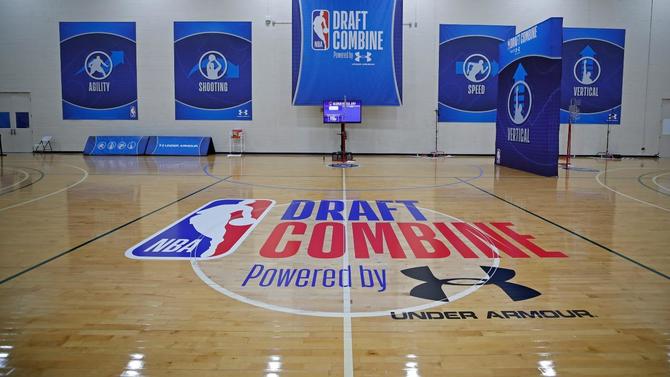
This might not slow the flow of underclassmen who declare, but it is going to put coaches in an interesting position with their roster arrangement, particularly when you combine this with the expected change in transfer protocol. One coach with multiple top-100 NBA prospects told me that he will not be providing a long leash on decisions. If quality transfers are on the table, he will need to know answers sooner than later from his potentially outgoing players; he won't be waiting until the end of May to get an answer.
Coaches on the whole do want what's best for their players -- and of course selfishly for their teams -- but the resources that won't be available for NBA prospects this spring is going to hit hard for those who are, or were, hoping to improve their stock in April and May. NBA front offices are already preparing for a worst-case scenario: relying solely on game tape and intel they can acquire over the phone. As with college basketball and recruiting, the NBA and some of its decision-makers could be caught flatfooted.
June 3 is the NCAA's deadline for underclassmen to decide to come back or not, but that date could easily change. Look for this to become one of the biggest subplots in the basketball world as we get into mid-April.
Schedule for next season already impacted
This is the place a lot of coaches and ADs don't even want to go to yet. Brey isn't one of them.
"I'm almost thinking I'm not going to see my guys until Labor Day weekend," he said. "Are we playing less basketball next year? Are we starting later, on Dec. 1? Jan. 1? It's all on the table."
Schools are already pulling back on scheduling practices. Brey explained that many schools' budgets will be highly affected and that will change how the nonconference slate is collectively built. At Notre Dame, they usually pay $90,000 apiece for seven "buy" games. Brey already said that's not happening next season. His number of buy games will go down and he's hunting for home-and-homes (which, by the way, is a good thing for college basketball) with good programs. That won't require cutting a check.
"The biggest concern, and our AD voiced it in an email, is the financial impact on the athletic department is going to be massive and how do we handle our budget," Brey said. "Using the private plane to recruit, the Power Fives? I don't know about that anymore. I don't even know if we're going to be out. The last 10 days, it's been a scramble mode. Not day-to-day: hour-to-hour."
There's also the radical downturn in our nation's economy, reverberations of which will be felt at the university level. To wit: a drought in donations from normally reliable outside sources who have deep pockets. Many boosters are not booming and it's a big concern. So coaches across the country have been doing reluctant check-ins with rich people to see where resources may or may not be.
One coach relayed this anecdote: in talking to a big booster this week, he learned nearly a third of that millionaire's money was in stocks, which have been brutalized in the past two weeks. Donations will be thinning, and that can impact a lot of programs -- in addition to the depleted payouts coming from the NCAA, due to not having an NCAA Tournament this year.
Additionally, there's already unease over whether some lower-tier multi-team exempt tournaments could not be held in November. The contracts for those tournaments usually get finalized in late March or early April, but multiple sources said all of that is on hold, creating a domino effect with coaches trying to assemble schedules. The logistics don't stop: because this is a presidential election year, the start of college basketball's season is pushed back a week for 2020-21, meaning fewer dates for supposedly the same amount of games.
We could have imbalanced scheduling at an unprecedented level -- and game inventory could vary by conference, not to mention the non-zero chance the season could face a delay.
A mid-major coach told me finding buy games is up in the air and it's an issue because he needs that money for his program in order for it to run functionally and fund the athletic department. Another coach said it is in his contract to schedule X-number of buy games per year that total up to at least $275,000 for his school. Come the summer, when the schedule scramble hits a frenzy, the money might not be there.
More money problems: many assistants at low- and mid-majors have their contracts expire annually each May. Renewals are seldom a problem, but that might not be the case this season. Assistants across the country, the majority of whom make well below six figures, are waiting to find out if contracts can be renewed on time. They're already losing out on making money on team camps (between $75,000 and $100,000 often split between five or six staffers; the head coach doesn't take money here), events that take place each summer but will now not be feasible.
"Like any small business owner, I'm trying to manage this the best I can for all my employees," a mid-major coach out west told me. "Certain athletic departments, I don't think the finances are guaranteed, so the sooner we can get what is guaranteed, the more stability we can create."
And coaches are willing to give up almost everything until the late summer if it means games (with or without fans) can start on time in November.
"The great unanswered question is how long is this going to be and the greater impact on financials," Brey said. "We need to be thinking about Sept. 1. Well, Aug. 1 for football, Sept. 1 for the rest of us. What happens on Sept. 1 when college football season kicks off and we have a new academic year and a new athletic year? That's what we need to be focusing on now. Kiss April goodbye, kiss May goodbye, kiss the summer goodbye. What can we do for the next five months to ensure that we can have a college football season and a fall sports season?"
So April has not yet arrived and this is already the largest, creeping worry: An extended national emergency with coronavirus, plus endangered economies nationally and locally, stand to threaten a traditional college basketball season for 2020-21.









